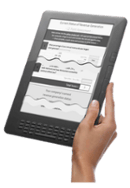“The goal of forecasting is not to predict the future but to tell you what you need to know to take meaningful action in the present.” - Paul Saffo

Market volatility and economic disruption are once again becoming the norm, making it more vital than ever that businesses have a strong grip on their revenue forecasts. Not only does strong revenue predictability provide a solid platform for critical decision-making, but it has also proven to be a winning business practice.
Research from the Aberdeen Group concludes that companies who have accurate sales forecasts have a 7.3 percent greater chance of hitting quota and are 10 percent more likely to grow their year-over-year revenue.
Sales forecasting is both an art and a science. The accuracy of a forecast can vary wildly from manager to manager, and, while these are predictions, precision matters. To overcome variations and better inform the 'art' of forecasting, there are a few "Must Ask" questions that should be on the list of every sales manager to ensure the progress of all opportunities and increase forecasting accuracy.
What is Sales Forecasting and Why Should You Do It?
Your company's sales forecast is a prediction of future sales over a set period, such as a month, quarter, or year. So, whether you have a single salesperson or an entire sales team, you should be able to produce a prediction for the value of the revenue sales will bring to the business.
For relationship-based sales, the sales cycle may be lengthy, have a high degree of complexity, and involve multiple influencers. For commodity sales, the cycle is shorter and could be more data-driven.
Sales forecasts take time and work, so wouldn't those resources be better spent selling instead of planning? Definitely not! When you have accurate sales predictions, your company can make more intelligent business decisions that affect the entire organization.
Sales forecasting allows your business to spot both problems and opportunities either before they arrive or before they accelerate. Since monitoring is a part of this process, you will have the chance to avoid or mitigate issues when you find that you are running below quota. If your sales forecast predicts a 30 percent increase in revenue, this will drive other business decisions related to production, resources, and personnel. In either case accuracy is critical.
Your company's sales forecast is also a powerful tool for motivation.
For example, you may have an ambitious quarterly sales forecast, which you break down into monthly and even weekly targets. Provided the goals are measurable and achievable, you can use them as a means to motivate progress within your organization.
Of course, inaccurate forecasts can be equally problematic if they lead your company to take erroneous actions or create despondency among the sales ranks. This is why is it essential that you are using the right data and methods to produce your sales forecasts.
The Foundational Elements of a Sales Forecast
When you build your sales forecast, you will need to include a variety of data from several sources. The most accurate sales forecasting requires the following elements:
- Sales Funnel. Your team will need to sit down and agree on how and when to count leads entering and exiting your sales funnel. Shared definitions for opportunity, lead, prospect, and close are a must.
- Sales Pipeline. A clearly defined, structured, and documented sales process is also essential. If salespeople aren't using the same steps and stages, you won't be able to accurately predict a sale or closing.
- CRM Tool. The data from your company's CRM system is an invaluable tool for giving accurate predictions on sales closures.
Building a Smart Sales Forecast
Making good business decisions and producing exemplary results depends on more than just a string of lucky choices. You need dependable data and processes. To begin forecasting your sales, you should first gather the right information and then apply it to your chosen process.
- Align Goals. Speak with your team about their goals for this defined period. Does their forecast support their goal achievement for the period? It is essential that their activities lead to sales target achievement. A sales forecast is a snapshot of their progress for a given time period.
- Choose Your Forecast Method. There are several different ways to forecast your sales. Some of the most common methods include:
- Historical Forecasting. A fast, though less than accurate, way to forecast sales figures is to look at past sales data and then assume that your future results will be either the same or better.
- Opportunity Stages Forecasting. This method looks at the stages of the sales process that individual deals are in to forecast closings.
- Intuitive Forecasting. This is a guesswork type of forecasting in which sales managers ask their reps for estimates on sales closing dates and values.
- Length of Sales Cycle Forecasting. This method looks at the age of individual opportunities to forecast when they are likely to close.
- Multi-Variable Analysis. Probably the most sophisticated sales forecasting method, this requires using predictive analytics and then applying factors such as mean sales cycle length, individual salesperson performance, and the probability of closing a sale based on opportunity type.
- Internal and External Factors. No matter what sales forecast method you choose, there are many internal and external factors that could impact your results. Some of the internal factors include sales territory shifts, compensation plan changes, and staffing changes. External factors include economic conditions, competition, seasonality, new products, and legislation.
- Timing and Frequency. Sales targets and goals are typically created for the year. A sales forecast is generally for the current month with a forward look at an additional two months. The forecast is created every month and may be adjusted for the current month at the mid-month mark.
The Must-Ask Questions for Your Team
When you create a sales forecast, this should be a group effort. Receiving input from everyone involved in the sales and operations process is one of the ways that will give you the most accurate results. As you do this, you will want to ask your team several key questions:
- Why is our solution better for the client than the one the competition is proposing?
- Why do you believe this opportunity is going to close when you say it is?
- What might cause it NOT to close when you project that it will?
- Are there enough real deals in the pipeline to support this forecast?
When you interpret the answers to these questions, you should also factor in who is giving the responses. In other words, know the types of people on your sales team and gauge their answers accordingly:
- The Rock Star. These salespeople aggressively pursue leads and have a low fear of rejection. They may give you overly optimistic sales projections and be willing to bet on new, unproven methods for generating sales.
- The Career Salesperson. A career salesperson will probably give you some of the most realistic answers to these questions because they place a higher value on client satisfaction than making the sale. They have a more intimate understanding of the internal and external factors that can impact their sales forecast.
- The Underperformer. Any underperforming salesperson has a greater tendency to hedge when forecasting sales. The less effort required to meet quotas and earn compensation, the better.
Applying What You Know to the Forecast
When you combine all of the determining factors, including the answers to those must-ask questions, you need to determine your level of confidence in its predictions. How do you know if you have a valid sales forecast? The most obvious validation is actual sales that fall in line with your predictions. Depending on your forecasting method, you can also measure the growth in your sales pipeline.
Sales forecasts must be closely monitored for accuracy and any inconsistencies in the factors used to create the numbers. Review the figures regularly with your team and make adjustments when needed. The forecast should always be up to date in the CRM system so that sales teams are working towards closing the right sale at the right time.
When and How to Publish Your Forecast
A sales forecast is nothing more than a tedious exercise if you don't put the plan to use. A variety of people in your organization rely on the sales forecast to effectively do their jobs, the CFO and the COO (or their equivalent) in particular.
The CFO relies on an accurate forecast to help them create cash flow projections, as well as giving the CEO an accurate picture of what the company's overall future looks like. The COO relies on an accurate forecast to inform material and personnel resource requirement decisions. And, of course, the sales leader relies on the forecast as a means of assessing sales performance, informing next year’s goals and skills training needs.
In most organizations a sales forecast is generated at the beginning of each month for the current month and next three months. For greater accuracy the current month is updated at the mid-month mark and may be adjusted as month end approaches.
Forecasting is vital, but it shouldn't be so time-consuming that it becomes a burden or a drain or sales resources. Your sales team should have a process in place for its projections that isn't onerous, and that leaves plenty of time for the business of selling. A CRM tool that has been effectively implemented and is actively utilized by the sales team is the key component required to create and publish an accurate sales forecast.
In an ultra-competitive environment, no matter how good your company's products or services may be, the most significant contributing factor to success and long-term growth lies in the ability create, implement, and execute winning sales strategies. This requires a team that is focused on planning, which includes creating a system for smarter sales forecasting.
Need help with developing a sales forecast? Contact me here.
 You can also get immediate access to our Revenue Generation Assessment here. This free assessment is an online spreadsheet/calculator that helps you quickly review your revenue generation potential. It is simple and straightforward and can become a compass to keep your team focused.
You can also get immediate access to our Revenue Generation Assessment here. This free assessment is an online spreadsheet/calculator that helps you quickly review your revenue generation potential. It is simple and straightforward and can become a compass to keep your team focused.
